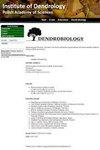Abundance and diversity of fungi in oak wood
IF 1.8
4区 农林科学
Q2 FORESTRY
引用次数: 8
Abstract
Deadwood is an important functional and structural component of forest ecosystems since it regulates nutrient cycling, serves as a carbon (C) pool, increases the C content in the soil, and is a source of resources, including water, for a wide range of saproxylic and non-saproxylic organisms. The abundance and diversity of wood-inhabiting fungi in six fallen, horizontally lying logs of Quercus petraea, in the 1st, 2nd and 3rd decay classes, in the Drawa National Park in Poland in 2015, were studied using the Illumina sequencing technique. The total number of OTUs obtained (264 307) included sequences of culturable fungi (242 369 = 91.70%) and non-culturable fungi (7 056 = 2.66%). The dead oak wood was colonized by 277 taxa. Culturable fungi of Zygomycota, Ascomycota and Basidiomycota comprised 75% of taxa detected and were represented by 14, 139 and 53 taxa respectively. Non-culturable organisms were represented by 70 taxa. Fungi were classified into 18 groups: (i) typical soft rot fungi, (ii) phytopathogens potentially hazardous to trees, (iii) epiphytes and endophytes or weak, opportunistic pathogens, (iv) ectomycorrhizal species, (v) ericoid mycorrhizal species, (vi) crust fungi, (vii) resupinate basidiomycetes, (viii) saprotrophs and soil fungi, (ix) opportunistic human pathogens causing superficial or systemic mycoses, (x) pathogens of warmor cold-blooded animals, (xi) ascomycetous yeasts, (xii) basidiomycetous yeasts, (xiii) antagonists of fungi, (xiv) producers of metabolites effective against pathogens, (xv) hyperparasites, (xvi) lichen-forming species, (xvii) partners of other fungi, (xviii) species rare or uncommon in nature. It was shown that: (i) coarse, woody debris of oak is host to abundant and diverse mycobiota, (ii) abundance and diversity of fungi increase with the decay continuum, (iii) oak logs can be a habitat of phytopathogens potentially hazardous to forest health, (iv) different phytopathogens favour wood in different decay classes, (v) abundance of pathogens decreases, and of ericoid mycorrhizal (or soil) species increases with the decay continuum. Maintaining different types of deadwood increases fungal diversity, but also the risk of diseases.橡木中真菌的丰富性和多样性
枯木是森林生态系统的重要功能和结构组成部分,因为它调节养分循环,作为碳(C)库,增加土壤中的C含量,是包括水在内的各种腐木和非腐木生物的资源来源。利用Illumina测序技术,研究了2015年波兰Drawa国家公园6棵栎树(Quercus petaea) 1、2和3级水平倒下的木材中栖息真菌的丰度和多样性。获得的otu总数为264 307个,包括可培养真菌序列(242 369 = 91.70%)和不可培养真菌序列(7 056 = 2.66%)。死栎树被277个分类群占据。扎菌门、子囊菌门和担子菌门的可培养真菌占检出分类群的75%,分别有14、139和53个分类群。不可培养生物有70个类群。真菌分为18类:(i)典型的软腐真菌,(ii)对树木有潜在危害的植物病原体,(iii)附生菌和内生菌或弱条件致病菌,(iv)外生菌根菌种,(v) ericoid菌根菌种,(vi)外壳真菌,(vii)复生担子菌,(viii)腐养菌和土壤真菌,(ix)引起浅表或系统性真菌病的人类条件致病菌,(x)温热或冷血动物病原体,(xi)子囊菌酵母,(xii)担子菌酵母,(xiii)真菌的拮抗剂,(xiv)对病原体有效的代谢物的生产者,(xv)超级寄生虫,(xvi)地衣形成物种,(xvii)其他真菌的伴侣,(xviii)自然界中罕见或不常见的物种。结果表明:(i)粗糙的橡木木屑是丰富多样的真菌菌群的宿主;(ii)真菌的丰度和多样性随着腐烂连续体的增加而增加;(iii)橡木原木可能成为对森林健康有潜在危害的植物病原体的栖息地;(iv)不同的植物病原体有利于不同腐烂类别的木材;(v)病原体丰度减少,而ericoid菌根(或土壤)物种的丰度随着腐烂连续体而增加。保持不同类型的枯木增加了真菌的多样性,但也增加了疾病的风险。
本文章由计算机程序翻译,如有差异,请以英文原文为准。
求助全文
约1分钟内获得全文
求助全文
来源期刊

Dendrobiology
农林科学-林学
CiteScore
2.20
自引率
11.10%
发文量
17
审稿时长
>12 weeks
期刊介绍:
Dendrobiology publishes original research articles and review articles related to the biology of trees and shrubs.
 求助内容:
求助内容: 应助结果提醒方式:
应助结果提醒方式:


